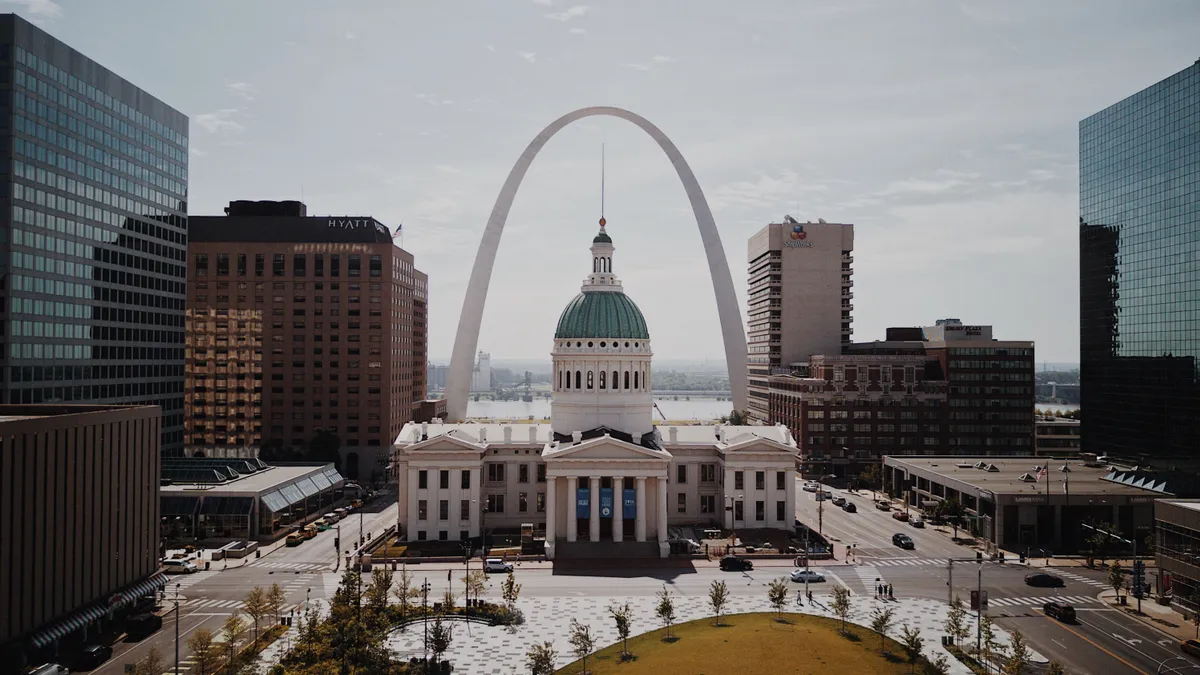Dive Brief:
- St. Louis last week became the first Midwest city to pass a Building Energy Performance Standard (BEPS) to advance the city's goal of eliminating community-wide greenhouse gas (GHG) emissions by 2050.
- The BEPS plan is applicable to buildings that are 50,000 square feet or larger and were already required to report their energy and water use under current city law. Under BEPS, those buildings will be required to meet various levels of energy performance and impose energy-saving actions, such as upgrading HVAC units, ventilation, lighting and elevators.
- The new law also sets up a Building Energy Improvement Board, which will be made up of nine members from utilities, labor, affordable housing owners and tenants, and commercial buildings. The board will help ensure buildings are complying with new standards and consider owners' alternative plans if compliance is not possible.
This week, I signed legislation sponsored by @HeatherNStL making @STLCityGov the first Midwestern city to require that buildings meet energy efficiency standards.
— Mayor Lyda Krewson (@LydaKrewson) May 7, 2020
You can read about our commitment to climate action with @NRDC here: https://t.co/QBEF0z04JV
Dive Insight:
Like in many cities, St. Louis' buildings sector is responsible for a tremendous amount of GHG emissions: an estimated 80%. This legislation represents a major step forward in trying to curb those emissions, and comes on the heels of St. Louis being named one of the 25 winners of Bloomberg Philanthropies' American Cities Climate Challenge.
St. Louis has already made steady progress in its climate goals. Last October, the city released its first energy benchmarking report for municipal and privately owned buildings that are over 50,000 square feet, and found that more efficient performance would reduce emissions by at least 11% and save more than $65 million in annual energy costs. Meanwhile, St. Louis is looking to be innovative in other areas, having experimented with a microtransit pilot and a smart cities pilot program.
St. Louis is only the fourth government to adopt BEPS, behind Washington, DC, New York City and Washington State. The Institute for Market Transformation noted the similarities between St. Louis' program and one passed in Washington, DC last year, although there are differences in timelines and the way they track energy use.
And in New York City, the Climate Mobilization Act that passed last year has provisions for bringing down buildings’ energy use, while the city went on to choose nine city facilities for deep energy retrofits. Washington State also has passed a statewide BEPS standard policy.
The Natural Resources Defense Council (NRDC), which backed St. Louis' BEPS, said the new law should mean long-term cost savings for St. Louis (after an initial investment), smarter buildings, more jobs created and more capacity for electricity, in addition to other benefits.
NRDC experts said even amid the new coronavirus (COVID-19) pandemic, St. Louis sets an example other cities can follow, "by demonstrating that it can drive climate action and unlock a wide range of associated benefits for building owners and the entire St. Louis community."















